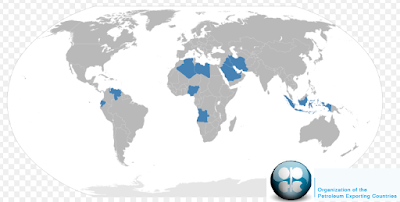KUALA LUMPUR, Dec 5 (Bernama) -- Bursa Malaysia closed lower on Friday amid mixed regional market performance as investors turned cautious over a possible rate hike by the Bank of Japan (BOJ) and upcoming US economic data that may influence the Federal Reserve’s (Fed) interest rate decision next week. At 5 pm, the FTSE Bursa Malaysia KLCI (FBM KLCI) pared most earlier losses to settle 4.55 points easier, or 0.28 per cent, to 1,616.52 from Thursday’s close of 1,621.07. The benchmark index, which opened 0.37 of-a-point lower at 1,620.70, moved between 1,609.67 and 1,621.25 throughout the day. The broader market was negative, with decliners outpacing advancers 604 to 439. A total of 550 counters were unchanged, 1,151 untraded, and 18 suspended. Turnover declined to 3.17 billion units worth RM2.24 billion from 4.48 billion units worth RM2.75 billion yesterday. Rakuten Trade Sdn Bhd vice-presiden...
Organization of the Petroleum Exporting Countries (OPEC) members met in Vienna yesterday, to a much anticipated outcome of once again failing to commit to any production targets (previously collectively 30m bbls/day). OPEC members will thus continue to produce output as they see fit. All is not lost however… we can see that members are beginning to build trust and discussed on issues that could eventually lead to the reinstatement of a production ceiling, coupled with mending their hostilities which were displayed in their previous meetings in December 2015 and April 2016. We retain our Neutral outlook on the O&G sector for the interim as we anticipate continued pressure on oil prices considering last night’s outcome that is expected to flood the market with further supplies yet again. Our average Brent oil price levels are predicted as follows: 2016 – USD44/bbl, 2017 – USD50/bbl and end 2017 – USD60/bbl.
Some agreements.
i) Appointment of Nigeria’s Mohammed Barkindo as the new secretary-general. He is the former head of Nigerian Petroleum Corporation.
ii) Re-entry of Gabon as OPEC’s 14th member, bringing in fresh supply of 240,000 of production. Other issues that were discussed saw that Saudi Arabia was open to a collective production ceiling (rumoured to be a collective limit of 32.0-32.5m bbls/day) but Iran maintained they would only support individual country quotas. These policies could lead to further negotiations in the coming months that could make the upcoming meeting scheduled for November 30 a possible game changer… or not. It was certainly too complicated and too early to be implemented yesterday however.
Notable developments
Saudi Arabia’s new energy minister Khalid Al-Falih shared a shift in tone for the nation, by emphasizing on the country’s desire for long-term market stability, and no desire for oil shocks. He continued to press on Saudi’s keen interest to revive OPEC’s relevance. We understand this was flagged by the potential for an oil shortage as investment cuts in the global energy sector has made historic waves to the potential depletion on production going forward, assuming these rate cuts are prolonged. Put it simply, OPEC controls about c.40% of the world’s crude output and any shortage going forward from the repercussions of global capex cuts would need to be filled. The fall in global energy investments by about 25% or USD126bn among all producers is forecasted by Consultancy Rystad Energy to reduce further by 1/5th this year.
Anticipated outcome
Since the flop of April’s Doha summit, the chances of a deal have narrowed, fueled further by the continued climb in oil prices to just around the USD50/bbl band. Despite OPEC’s hands-off policy for now, oil price dipped initially yesterday, but reversed course on figures showing that US crude stockpiles had fallen in the past week.
Oil price movement factors
US crude stockpiles fell 1.4m bbls last week according to Energy Information Administration (EIA). Futures also fell more than 1% yesterday on OPEC’s decision of a “no production ceiling” at this juncture.
Source: PublicInvest Research, 03 June 2016

Comments
Post a Comment